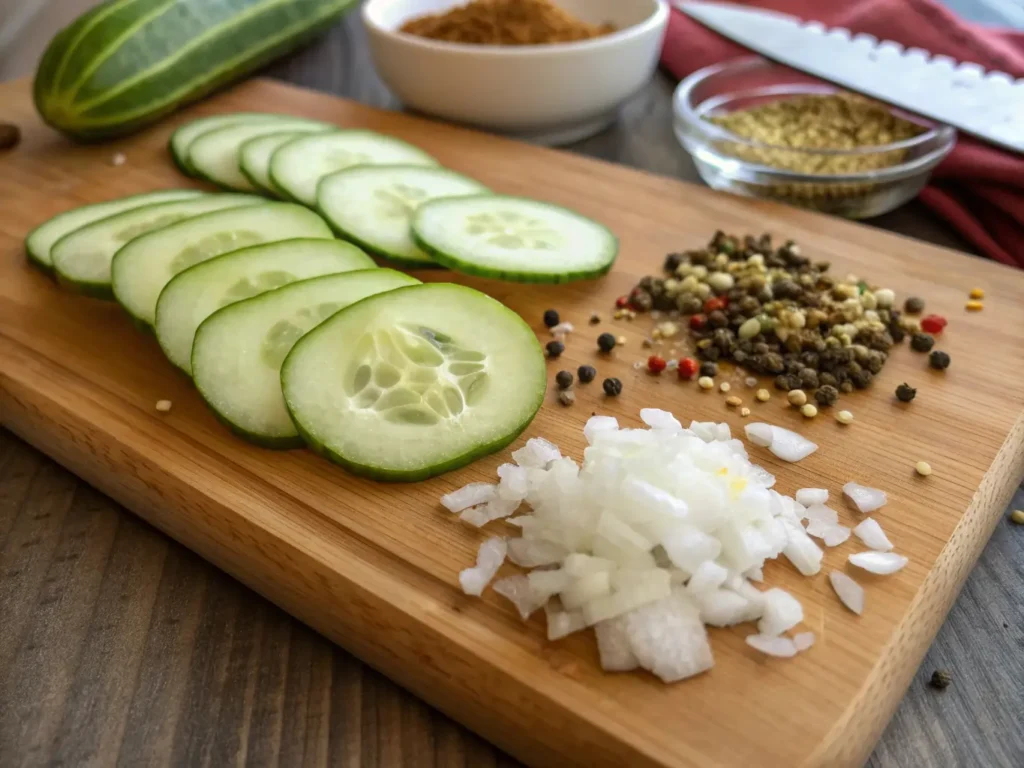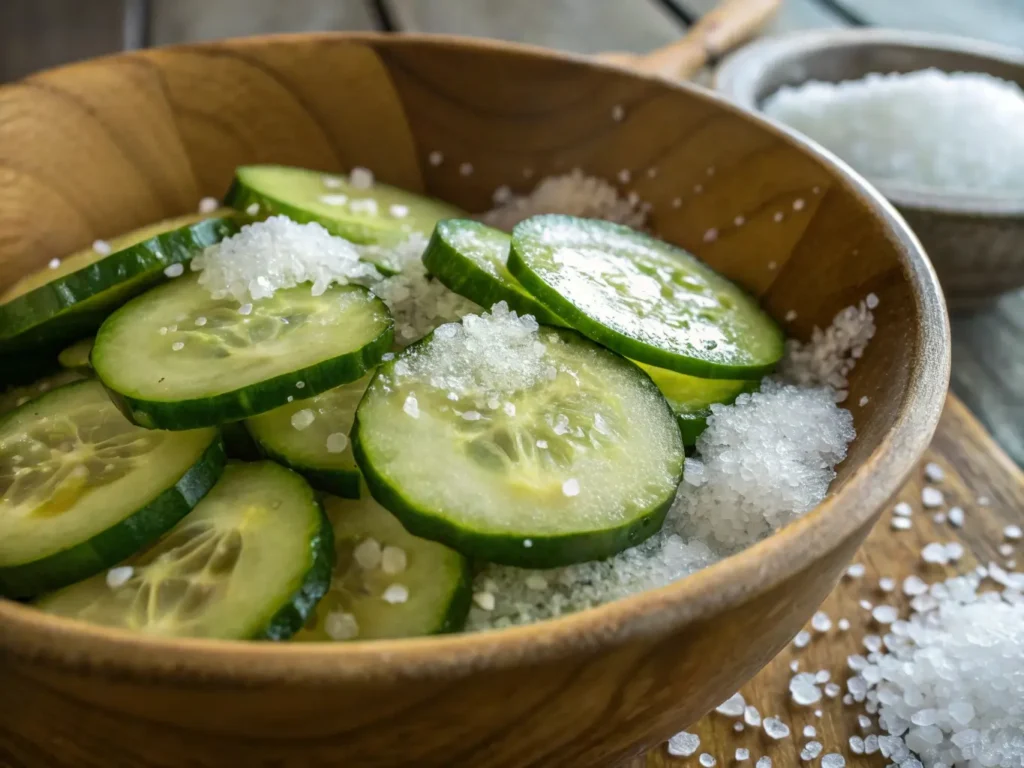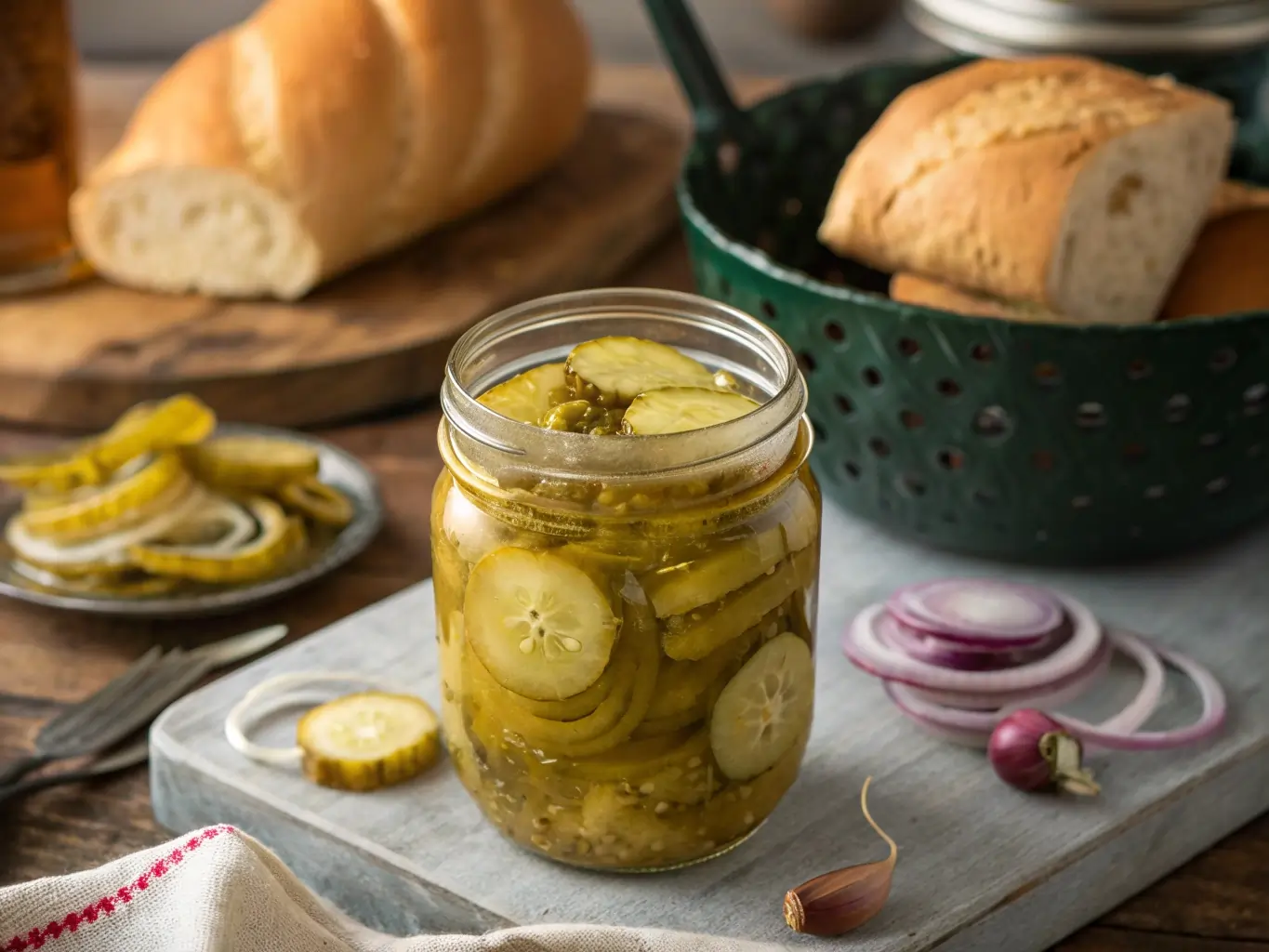Bread and butter pickles are a delightful blend of sweet, tangy, and slightly spicy flavors that have earned a permanent place in American kitchens. From topping juicy burgers to brightening up a simple ham sandwich, bread and butter pickles add a burst of flavor that transforms ordinary meals into something memorable. These golden-green pickles are as versatile as they are flavorful, making them a must-have in any pantry.
In this guide, you’ll learn the fascinating history of bread and butter pickles, how they differ from other pickles, and exactly how to make your own irresistible batch at home. We’ll explore the best ingredients, step-by-step recipes, storage tips, and even creative ways to use them in meals. Whether you’re a first-time pickler or a seasoned canner, this article will give you the skills and inspiration to create the perfect jar.
Table of Contents
What Are Bread and Butter Pickles?
The History Behind Bread and Butter Pickles
The origin of bread and butter pickles dates back to the Great Depression, when farmers Omar and Cora Fanning in Illinois used their surplus cucumbers to create a sweet-and-tangy pickle they could trade with a local grocer for essentials like bread and butter. This barter inspired the now-famous name. Over time, the recipe spread nationwide, becoming a pantry staple in American households. Today, these pickles are still prized for their balance of vinegar tang, sugar sweetness, and aromatic spices like mustard seed, celery seed, and turmeric.
Why They’re Called “Bread and Butter” Pickles
While the barter story is the most famous explanation, the name also reflects their popularity as an affordable, everyday food—something you could eat with plain bread and butter for a satisfying snack. Their mild sweetness and mellow acidity made them perfect for simple meals before refrigeration became widespread. Even now, that approachable flavor makes them a hit with kids and adults alike, and their nostalgic charm has kept them in cookbooks and family recipe boxes for decades.
Bread and Butter Pickles vs Regular Pickles
Taste, Texture, and Flavor Differences
When comparing bread and butter pickles to regular pickles, the most noticeable difference is in flavor. Bread and butter pickles deliver a sweet-and-tangy punch, thanks to sugar in the brine, while regular pickles—often called dill pickles—lean heavily on a tart, salty profile. The sweetness mellows out the vinegar’s acidity, creating a more rounded taste that pairs beautifully with rich or savory foods. In terms of texture, bread and butter pickles usually have a slightly softer crunch than crisp dill spears, though both offer that satisfying snap when you bite in.
Sweet vs Sour Pickle Varieties
The sweet profile of bread and butter pickles comes from adding sugar, turmeric, and spices such as mustard seed and celery seed. Sour pickles, on the other hand, skip the sugar and focus on vinegar strength, salt concentration, and sometimes fresh dill weed for herbal notes. Sweet pickles often take on a warm, golden tint from turmeric, whereas sour ones retain the crisp, vibrant green of fresh cucumbers. This difference in seasoning not only changes the taste but also how each type complements meals—sweet pickles work well with salty, smoky dishes, whereas sour pickles shine alongside fried or fatty foods.

Ingredients for Perfect Bread and Butter Pickles
Must-Have Vegetables and Spices
The star of any bread and butter pickles recipe is, of course, the cucumber. Choose fresh, firm cucumbers with thin skins, ideally pickling varieties like Kirby or Persian cucumbers, as they hold their shape and crunch better. Alongside cucumbers, onions are a classic addition, adding sweetness and depth to the brine. The spice mix is where the magic happens—mustard seeds for tang, celery seeds for earthy balance, turmeric for its golden color and subtle bitterness, and sometimes red pepper flakes for a gentle heat. Salt is essential, not just for flavor, but for drawing out moisture from cucumbers before brining.
Choosing the Best Vinegar and Sweeteners
Vinegar is the backbone of any pickle brine. For bread and butter pickles, distilled white vinegar is the classic choice—it delivers a clean acidity that lets the spices and sugar shine. Apple cider vinegar is another popular option, adding a fruity undertone to the pickle’s flavor. As for sweeteners, granulated white sugar is traditional, but some home picklers experiment with honey or maple syrup for a unique twist. Balancing the sweet and sour is key, and the ratio of vinegar to sugar often determines whether the final product is pleasantly sweet or cloyingly so.
The Step-by-Step Bread and Butter Pickle Recipe
Preparing Cucumbers for Pickling
Start by washing your cucumbers thoroughly to remove any dirt or residue. Slice them into uniform rounds—about ¼ inch thick—for consistent texture and flavor absorption. Layer the cucumber slices with thinly sliced onions in a large bowl, sprinkling kosher salt over each layer. This step draws out excess moisture, ensuring that the bread and butter pickles remain crisp after brining. Let the salted cucumbers sit for 1–2 hours, then rinse and drain well before moving on to the brining stage.
The 321 Rule for Pickles Explained
The 321 rule is a handy guide for achieving the perfect sweet-to-sour balance in your bread and butter pickles: 3 parts vinegar, 2 parts sugar, and 1 part water. This ratio keeps the brine tangy without being overpowering, while giving enough sweetness to complement the spices. Once your cucumbers and onions are prepped, combine the vinegar, sugar, water, and spices in a saucepan. Bring the mixture to a boil, then pour it over the cucumber and onion slices. Allow the mixture to cool completely to room temperature before spooning it into jars. For a longer shelf life, process the jars using the water bath canning method for 10 minutes.
Variations and Flavor Twists
Spicy Bread and Butter Pickles
If you like a little kick, you can easily transform classic bread and butter pickles into a spicy version. Add red pepper flakes, sliced jalapeños, or even a dash of hot sauce to the brine for extra heat. The sweetness from the sugar balances the spice, creating a bold, layered flavor that pairs especially well with fried chicken or grilled meats. For an extra pop, try adding crushed coriander seeds, which enhance both the heat and the aromatic profile.
Garlic-Infused and Dill-Enhanced Versions
Garlic lovers can toss in a few crushed garlic cloves during the brining process for a savory depth that complements the pickle’s sweetness. Fresh dill or dill seed also makes a great addition, bringing an herbaceous brightness similar to dill pickles but with the sweeter backbone of bread and butter pickles. Try pairing garlic with dill to create a richer, more layered depth of flavor. These variations keep the recipe fresh and customizable, so you can tailor it to your personal taste or the preferences of your family.
Storing and Preserving Bread and Butter Pickles
Water Bath Canning Method
For long-term storage, the water bath canning method is the gold standard. After packing your bread and butter pickles into sterilized jars, cover them with hot brine, leaving about ½ inch of headspace. Wipe the rims clean, apply lids and rings, and process the jars in boiling water for 10 minutes. Once processed, remove the jars carefully and let them cool undisturbed for 12–24 hours. The sealed jars can be stored in a cool, dark pantry for up to a year without losing flavor or texture.
Refrigerator Pickle Method
If you prefer a quicker option or want to skip canning entirely, the refrigerator method is perfect. Simply pour the cooled brine over your cucumbers and onions in clean jars, seal them tightly, and refrigerate. Bread and butter pickles made this way develop flavor in about 24 hours and stay fresh for up to 3 months. The refrigerator method preserves a slightly crisper texture and is ideal for small batches you plan to eat soon.
Creative Ways to Use Bread and Butter Pickles
Sandwiches, Burgers, and Wraps
Bread and butter pickles are the secret weapon for elevating everyday sandwiches and burgers. Their sweet-tangy crunch balances rich meats like pulled pork, grilled burgers, or roasted turkey. You can layer them in chicken wraps, tuck them into sliders, or even use them as a topping for hot dogs. Their flavor cuts through heavy sauces and cheeses, adding a refreshing contrast that keeps each bite lively.
Salad, Relish, and Appetizer Ideas
Chop bread and butter pickles into a tangy relish for tuna salad, potato salad, or deviled eggs. You can also fold diced pickles into cream cheese for a quick cracker spread or use them as a garnish for charcuterie boards. They even make a great companion for Southern-style pimento cheese sandwiches or as a tangy topping for grilled fish. The versatility of bread and butter pickles means they can easily move from a casual backyard BBQ to an elegant appetizer tray.

Health Benefits and Nutrition Facts
Calorie Count and Nutritional Value
Bread and butter pickles are relatively low in calories—about 20–25 calories per ounce—making them a flavorful addition to meals without significantly increasing caloric intake. They provide a touch of vitamin K from cucumbers along with antioxidant benefits from turmeric. However, they can be high in sugar and sodium depending on the recipe. If you’re watching your salt or sugar intake, portion control is key.
Low-Sodium and Sugar-Free Alternatives
For a healthier twist, try reducing the salt in the brining process or using a salt substitute. You can also replace refined sugar with alternatives like stevia, monk fruit sweetener, or honey to lower the glycemic impact. Vinegar-based brines already act as a natural preservative, so these changes won’t compromise food safety. With the right adjustments, you can enjoy bread and butter pickles more often without worrying about excess sodium or added sugars.
Conclusion
Bread and butter pickles have stood the test of time for a reason—they’re easy to make, versatile in the kitchen, and full of nostalgic flavor. From their humble beginnings as a barter item to their place on today’s gourmet burger plates, these sweet and tangy pickles continue to bring joy to home cooks and food lovers alike. With the right cucumbers, a perfectly balanced brine, and your choice of flavor variations, you can create a batch that’s tailored to your taste. Whether you prefer them spicy, garlicky, or classic, bread and butter pickles are a delicious way to preserve summer’s bounty and enjoy it all year long.
For more recipes, follow me on Facebook and Pinterest.
FAQs
Why do they call them bread and butter pickles?
The name comes from the 1920s, when Illinois farmers Omar and Cora Fanning traded their sweet pickles to a local grocer in exchange for staples like bread and butter. Over time, the nickname stuck and became the official name.
What is the difference between bread and butter pickles and regular pickles?
Bread and butter pickles are sweet and tangy, while regular pickles—often dill pickles—are mostly sour and salty. The addition of sugar and warm spices like mustard seed and turmeric sets bread and butter pickles apart.
What is a bread and butter pickle?
It’s a type of sweet pickle made with cucumbers, onions, vinegar, sugar, and spices. Known for their golden color and balanced flavor, they’re popular on sandwiches, burgers, and in salads.
What is the 321 rule for pickles?
The 321 rule is a brine ratio: 3 parts vinegar, 2 parts sugar, and 1 part water. It’s used to create the perfect sweet-and-sour balance in pickles.
Share Your Experience
There are no reviews yet. Be the first one to write one.

